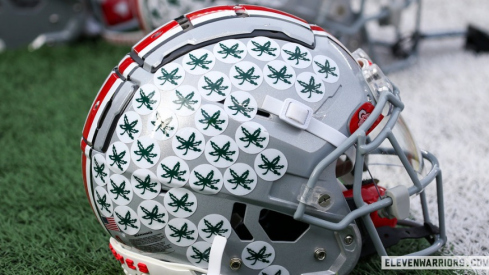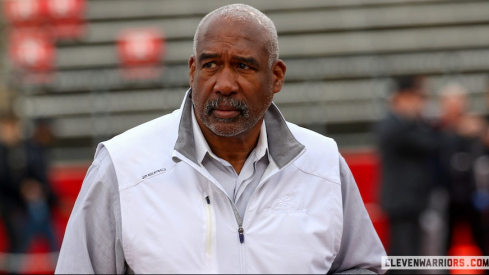
Ohio State's defense looked like a different unit against Michigan State on Saturday. And it was not simply because of new schemes or new personnel. Rather, there was simply a soundness and crispness to everything the Buckeye defense did, from the mixing and matching of play calls to the fundamental way those schemes were executed. The Ohio State defense was the team's backbone against the Spartans and the primary reason that the Buckeyes were able to overcome three turnovers to win a hard-fought road game. The crucial difference appeared to be that the Buckeye defense finally implemented a philosophical identity that put everything else into place.
IdEntity Check (Bring on the Cover 4)
The Buckeye defensive coaching staff exhibited a heretofore unseen ability to mix and match coverage schemes to attack Michigan State by down and distance. This ability to offer change-up looks stemmed from the Buckeyes having a base defense rather than searching for answers. Specifically, the Buckeye coaches finally jumped feet first into playing the 4-3 under/4-2-5 over to the field, cover-4 defense that OSU long intended to play, particularly on first down.

This allowed the Buckeyes to adjust to anything Michigan State attempted to do. From the outset, the Spartans sought to exploit the Ohio State weakness this season of defending plays into the boundary. MSU traded their TE and H-Back into the boundary to re-establish strength. Yet against Michigan State, Ohio State's defense quickly adjusted. The linebackers in particular made a concerted effort to widen themselves back towards the shift.
From there, the Ohio State safeties played aggressive cover-4 run support. The result was that the Buckeye defense's force-lever-spill went from being nonexistent to exhibiting textbook crispness. For instance, here, Storm Klein takes on the lead blocker in the hole, forcing Le'Veon Bell to spill. The cover-4 force safety Ohrian Johnson then comes downhill when the No. 2 receiver to his side shows run action, providing the Buckeye defense the force contain it was previously lacking.
The Buckeyes also played quarter-quarter-half in run downs, particularly when Michigan State put their tight end into the boundary. The weakside cover-2 put Bradley Roby as the force player to the boundary, an advantageous situation for OSU because Roby is such a physical presence in the run game. Weakside force is a strength of this coverage and showed that the defensive coaching staff were well aware Michigan State would attempt to exploit Ohio State's previous boundary weakness.
Cover-4 also allowed OSU to play more aggressive pattern matching pass defense. Given the MSU pass distribution, this often left the OSU cornerbacks in outside man coverage. Note against the play-action below how the OSU safeties initially come forward when the No. 2 receivers show run action, demonstrating that Ohio State was finally playing cover 4 as intended.
Once Ohio State adopted a defensive identity, everything flowed from there. The players had a system to execute and the coaches could use change-ups to this philosophy, such as single-high safety coverage. Where before OSU was searching for what to run, against the Spartans the Buckeyes finally seemed to know what they wanted to do. Everything comes together in the clip below—the Buckeyes easily adjust to the TE yo-yo motion, and OSU executes their cover-4 run support responsibilities.
Its Third Down and One of us is Fixin' to Score
With apologies to Bobby Bowden, the OSU defense will not be confused for a blitz happy unit. But the Buckeyes nonetheless displayed a different third down approach. In pass situations, the OSU defense generally operated from a single-high safety look. From there, the Buckeyes primarily played some form of cover-1 man coverage, often with a 5th or 6th rusher.
The Buckeyes would also mix in zone blitzes with three deep coverage behind. Sporadically they would use a three-deep, five-under drop. But by operating from a one-high look, OSU kept Michigan State from determining pre-snap what coverage they would run and how much pressure they would bring. This allowed the OSU defensive coaching staff to liberally change up these looks to keep the Spartans off-balance. The OSU defense again operated from a framework which allowed them to strategically mix and match looks, rather than merely adopt a hodgepodge approach.
The Hankins Supremacy
Johnathan Hankins made the game plan look even better. Hankins' presence turned the Ohio State weakness of defending boundary run plays into a strength. As the 3-technique, Hankins is the crucial fulcrum for this scheme. With OSU playing their fronts to the field, Hankins is to the boundary with the under front;

and to the field with the nickel over.

As such, the 3-technique is perhaps the most crucial defensive lineman for Ohio State against the run. Against the under, when a team puts their formation and runs to the boundary then, the 3-technique must hold its position and re-direct the running back. As seen in the first video above, Hankins 're-sets' the line of scrimmage, forcing the running back to bounce (see also video 5). With OSU fixing its force and spill techniques to the boundary, Hankins was able to turn a weakness into a strength, preventing the Spartans from running away from the numbers' strength of the Ohio State front.
Conversely, Ohio State is taking a defender out of the box with the nickel defense. Therefore, Ohio State's field-run defense must be stout at the point of attack to the field to allow defenders to amass. Again, with Hankins at the 3-technique the Buckeyes were able to do so. Hankins has taken his game to another level, making the Buckeye defense very difficult to run against.
These guys ain't half bad...
It also did not hurt that multiple Buckeyes had their best games of the season. Etienne Sabino deserves mention. I previously discussed how the Buckeye linebacking corps failed to play downhill. Sabino changed that against Michigan State. He continually pursued downhill away from run action, making numerous tackles in the hole. Sabino had his best game as a Buckeye, an encouraging sign for Ohio State.
Ryan Shazier also showed his continued development and was perhaps an unsung hero. On third downs, Ohio State often lined Shazier up over Dion Sims in its odd package, giving him the assignment to engage Sims in man coverage.
Shazier handled this assignment admirably, as Sims was largely a non-factor. The fact that Shazier has gotten to the point where he can handle such an assignment is a step forward for a player that has been an athlete playing linebacker. Nathan Williams also had his best game since his return from microfracture surgery. Williams was more fluid and active than he has been, and that presence made a sizeable difference for the Buckeyes.
The question becomes: was this a reflection of the offensive talent for Michigan State or a burgeoning trend? At first glance, the defensive performance appears to be the symbiotic execution of a systematic game plan with the Buckeye defenders being able to work within that framework for success. We will have to watch for whether Ohio State is able to carry that over against Nebraska, who has a speedy gamebreaker that Michigan State lacked.
Nebraska: Mixing and Matching the Run Game
Nebraska operates primarily from the shotgun-spread but will also run lead zone plays from under center. The Cornhusker goal is to grind yards with Rex Burkhead and then create big plays off reads with Taylor Martinez. To do so, Nebraska's favorite play is inverted veer. It fits Martinez's strength, which is accelerating north and south. Nebraska can then use Ameer Abdullah on the sweep portion.
If Ohio State is able to execute cover-4 as it did against the Spartans it should be well-positioned to play the Cornhusker run game. As demonstrated , the safeties can attack the edge upon run action. The Buckeyes will need this defensive back support because they had difficulty defending the inverted veer last year against both Nebraska and Michigan. The problem in both cases was linebacker pursuit. Needless to say, the Buckeye linebackers must continue the pursuit angle improvements they made Saturday.
Ohio State will also need to be chary with how much cover-1 they play on third down. Martinez is an obvious scramble threat and Nebraska likes running QB draws. In fact, Martinez had a long touchdown run on such a draw Saturday. The Buckeyes need to ensure the back seven has eyes in the backfield. But most importantly, Ohio State simply needs to build upon the game plan they used Saturday because the defensive looked cohesive top to bottom for perhaps the first time this season.

